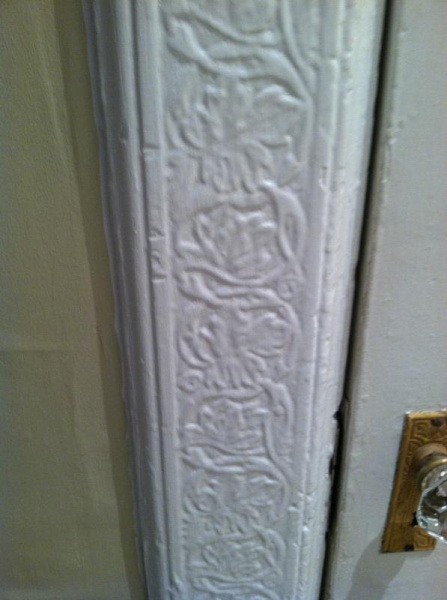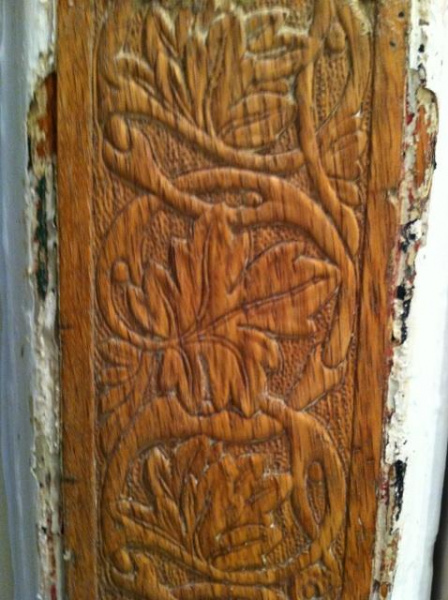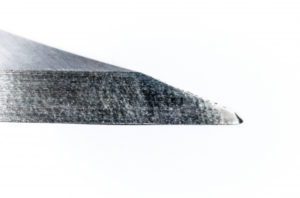About Us
High quality, safe, eco-friendly paint stripping products
- Eco-Strip makes it a priority to educate the general public and contractors about lead safe work practices when stripping paint with lead.
- We work hard to support “green” products and processes and to be eco-friendly. Our infrared paint stripping method eliminates toxic lead vapors and greatly reduces lead paint dust in the environment. Our manufacturer eliminated plastic product packaging and our warehouse uses only biodegradable shipping materials.
- Eco-Strip conducts independent laboratory tests to prove the safety and quality of our products.
- We provide exceptional customer support. Eco-Strip ships within 24 hours on business days and our repair center provides a two-day turnaround. We provide first line technical consulting on many paint stripping products, not just our own, and utilize our network of highly-experienced tradespeople for our customers.
- We volunteer our time and products to national associations related to historic restoration including the Window Preservation Standards Collaborative, Preservation Trades Network and the Window Preservation Alliance.
”I've never seen anything like it. It literally took only a few seconds to make the paint bubble. Your scrapers are the best I've ever used and I have lots of them. I like quality tools and yours are great.
Seth W.Retired DIY Homeowner Remodeling his 1956 home







Why are Speedheater™ scrapers better than the cheaper ones from hardware stores?
Not all paint scrapers are created equal. Cost, quality, and effectiveness vary.
Our scrapers are pull type. Most people use putty and drywall knives to push paint off. Pushing is less effective than pulling heated, soft paint. Speedheater™ scrapers have ergonomic, easy-grip and long handles that allow you to use both hands and apply more even and wider pressure on resistant paint.
Our scraper blades are made of steel that is harder and thicker than most lighter, more flexible metal scrapers. The Speedheater™ blade steel is “spring steel” which resists chipping and bending when it hits hard objects like nails. Our blades have very sharp, beveled edges. These blade edges quickly, evenly and thoroughly strip away paint down to the bare wood in just a few strokes. They also prevent damage to wood which duller, uneven blades might do. Speedheater™ scrapers blades have different edge profiles: convex and concave curves; and wide and narrow straight edges. Selecting the scraper with the blade edges which match the flat or curved surfaces you are stripping is key to efficient and effective scraping.
The Speedheater™ method of using infrared to soften the coating and matching the right Speedheater™ scraper make the job of stripping paint or varnish easy. No matter if a surface is flat like exterior siding or curved like interior doors, baseboards, or intricately carved wood, this method cleanly, safely, and efficiently gets a thickly-painted surface immediately ready for new paint.


What is the difference between heat guns and Speedheater™ Infrared Paint Removers?
A. Area stripped: The Speedheater™ Standard 1100 heats a 3” x 10” area evenly with only one application. The specific infrared wave lengths used in the Speedheater™ heat only what is directly in front of the heat source. They do not heat the surrounding area. Heat guns blow super hot air unevenly across a strip only several inches wide. The heat gun has to be in constant motion which makes it difficult to control where and for how long the paint is heated.
B. Paint temperature required to make the paint bubble: The Speedheater™ infrared rays need only to heat the paint to 400-600℉ to separate the bottom layer of paint from the wood. Heat guns must heat paint from the top down to 1000℉ to make it bubble for scraping.
C. Risk of fire: The blowing hot air of heat guns goes between and under boards and into crevices where dust and debris can easily ignite. The high heat penetrates onto the reverse side of the wood and into the materials behind the wood. Undetected from the surface, these can catch fire later after the stripping is done. The infrared rays create heat only in the upper portion of the wood and in the paint. They are not pushing heated air. The rays do not heat the back side of the wood or behind it.
D. Operator skill: The infrared bulbs of the Speedheater™ evenly heat paint in one application to a lower temperature. It requires less operator skill to safely monitor the heating. Using the Speedheater™ pull scrapers one can quickly remove all the paint layers down to the bare wood in a few, long strokes. Heat gun operators traditionally use dull putty scrapers. Push scraping at the correct angle with each stroke is difficult. Reheating and rescraping is often necessary to remove the paint thoroughly. Without experience, it is easy to mar the wood using these common tools.
Is the Speedheater Method safe for people?
Lead in paint turns into invisible, toxic fumes at 900-1000℉. Using a very specific infrared wave length, the Speedheater™ does its job very differently and with the paint only at 400-600℉. Lead fumes are not created at this low temperature. The wave length is not harmful to the eyes; it is the same as what the embers of an open fire emit.
Wearing heat-protective gloves, eye protection, and a respirator or dust mask is recommended. Lead paint debris must be thoroughly contained and carefully disposed of. For more information about how to follow Lead-Safe Work Practices in the US, visit: https://www.epa.gov/lead. For other countries, always follow laws and regulations regarding hazardous waste.
Can I use the Speedheater™ on both the inside and outside of my house
The Speedheater™ works well on both exterior wood such as siding, window trim and porches and on interior woodwork such as baseboards, doors, windows, floors, and cabinets. Proper ventilation is needed when you work inside.
Close all doors and all but one window. Place a window fan in this open window to pull the paint (not lead!) fumes outdoors.
On what kinds of coatings do the Speedheater™ work?
Speedheater™Infrared Paint Removers work best to heat oil-based paint and varnish and latex paint. They also heat acrylic and plastic paint; however, these coatings heated can be gummy and require frequent cleaning of the scrapers. Milk paint and shellac will heat but require more back and forth scraping. Infrared heat does not release stain as its pigment has soaked deep into the wood grain.
On what kinds of surfaces does the Speedheater™ work?
Speedheater™ was designed to work on wood. It is also effective on metal window bars and sheet metal painted with oil-based paint. On plaster and sheetrock, the paint may soften but the scraping may damage the surface. The Speedheater™ is less effective on thicker metal, marble, concrete and other stonework as the heat tends to dissipate into these. On brick, the paint may separate from most of the surface, but the brick’s uneven surfaces make complete scraping the soft paint difficult and damaging to the scraper blades. For most of these non-wood applications, we recommend environmentally-friendly chemical strippers.
How is the wood affected?
Using the Speedheater™ Infrared Paint Remover is the gentlest method for stripping wood. Excess moisture is drawn out of the wood. Mold and mildew spores and algae are killed. The natural resins deep in the wood are brought to the surface. This rejuvenates the dry wood, creates a porous substrate for the new primer to grip onto and thus extends the adherence and life of the new paint. In addition, infrared heat opens the grain of the wood much more effectively and without damaging the wood. With our sharp, pull-type scrapers, the wood is scraped cleanly but with sufficient tooth for strong, new paint adhesion. With wet stripping methods, there is chemical residue, neutralizer, or water remaining in the wood to potentially cause the paint to fail later. With sanding, dry scraping, or paint shaving, the wood surface can be marred.
You can do a simple test to see how well the grain of the wood opens and becomes porous using different paint stripping methods. On one painted board, heat and remove the paint in one section with the Speedheater™ Infrared (IR) Paint Remover. On different sections, use other methods. Then pour a small amount of water on each method’s section. On the section of bare wood stripped with infrared rays, the water instantly gets absorbed into the wood. On the sections stripped using other methods, the grain is not opened sufficiently to allow the water to be absorbed as much or not at all.
When is the best time of year to strip paint using infrared heat?
Paint can be removed with infrared at any time of the year, including winter. However, if the ambient air temperature around the work area is below 50℉, the heating time will greatly increase. The wood is much colder at the start. In addition, the cold air quickly cools down the heated paint and makes it re-adhere and harden again. It will me more effective and efficient to find a heated facility or to wait until warmer weather. Windy conditions can reduce the effectiveness of the Speedheater™. Wind may blow away the infrared rays which need to stay pointed directly at the painted surface to be most effective. Protecting a work area from wind prevents this.
How quickly can I repaint wood stripped with Speedheater™Infrared Paint Removers?
Immediately! The scraped wood has sufficient roughness for the new paint to adhere well. Wood stripped with infrared is left at the perfect moisture content (less than 10%) for long-lasting paint adhesion. Do not leave bare wood exposed to the elements for extended periods of time. The bare wood can quickly absorb moisture again. Wet wood is the most common cause of paint failure. We recommend stripping exterior paint when the outside temperatures make immediate repainting possible.
What if my paint is very dry, cracking, and peeling?
Decades of weathering can evaporate the oil or other solvents in paint. If you apply the Speedheater™Standard 1100 to a coated surface and it does not bubble and slightly smoke in 20-60 seconds, this may be the case. The infrared rays need the liquid to break the bond between the surface and the paint. You can correct this situation by applying linseed oil to the specific areas not reacting to the rays. The linseed oil can be applied with a brush or diluted with mineral spirits (at a 4:1 ratio) and sprayed from a garden pump sprayer. Allow the linseed oil to set on the coating overnight. This oil rejuvenates the dry paint and soaks into any bare wood to prevent it from scorching while heating the adjacent painted areas. The linseed does not impact the adhesion of the new paint.
What if I can’t get all the paint or varnish off in one heating and scraping?
Keep your scraper blades sharp. You may need to heat the surface longer. Let the wood and paint cool off slightly by working on a new area where you apply the heat a few seconds longer and scrape. Then return to the first area. Because the wood in this first area may be more exposed after the first scraping, apply the heat for much less time than the first time so that you do not scorch the wood. You also can spray the wood with water to prevent it from scorching. Scrape the remaining paint off. Remember to use that longer heating time with the other areas.
How do I effectively use the pull-type paint scrapers?
Choose the scraper with the edge which best fits the profile of the surface to be stripped. Grip the rear of the long scraper handle with one hand. Position the handle parallel to the painted surface. Put the blade edge into the heated paint. With your other hand closer to the blade, cut through all the layers of paint, apply pressure and pull the scraper towards you. The goal is to cut through all the layers of paint and remove them all in as few strokes as possible.
How do I sharpen the scraper blades?
Most paint scraper blades are made of thin metal. Our scrapers are manufactured in Sweden with “spring steel.” This steel is harder, thicker, and resists chipping and bending. Our blades have beveled edges which allow our pull scrapers to thoroughly strip away soft paint in a few strokes. Sharpening beveled-edged blades can be a challenge for DIY homeowners. Our Swedish manufacturer, Speedheater™ Systems, solved the problem with their new Grinding Kit. The Grinding Kit has two ceramic grinding cloths and a blade holder. Both the grinding cloths and the holder are durable and reusable. Scraper users especially like the portability of the Grinding Kit and the security of knowing they aren’t damaging the blade’s beveled edge.
Blade Sharpening Process:
- Place the Grinding Kit’s blade holder in the hole in the top side of a blade. This faces the bottom edge of the blade down.
- Holding the handle securely with your fingers, evenly press the blade down on the abrasive paper. With a steady downward pressure on the holder, move the blade in circles around the abrasive cloth. Do this for about 10-20 seconds. This circular motion, instead of a back and forth motion, sharpens all the blade’s edges evenly.
3) If you are using many blades for a big project, you may want to use an electric, wet grinder wheel to sharpen your blades. But be very careful not to heat and grind down the beveled edge. This beveled edge is what makes our blades so much more effective than flexible putty knives or inexpensive and thinner blades with short handles.
How to Attach Scraper Blades to Handle
The Speedheater™ scraper blades must be attached firmly to their long, ergonomic handles to work efficiently. If the blade wobbles or moves in any way, the scraping will not be even and will gouge the wood. To attach the blade, place it on the end of the handle. Push it down as far as it will go without stripping the threads. Use a wrench to tighten the blade until it is completely horizontal to the handle rod and does not move in any direction.
